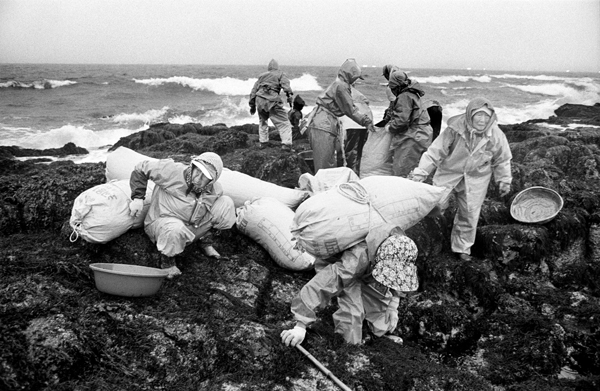| |
 |
|
| Haenyeo lift 20kg sacks of their seaweed catch in high winds and inclement weather. Photo by Lee Seong-Eun |
Jeju island is renowned for its “samda,” or three plenties of wind, women and stone. It is unsurprising, therefore, that several famous photographers have tried to capture its invisible wind with the click of a shutter.
Lee Seong-Eun is one such documentary photographer and through her images we can see a group of islanders that lives amongst and embraces this strong island wind: the halmang haenyeo, or grandmother women divers.
Without the strong Jeju wind, the island’s sturdy thatched houses, or chogajip, would never have been built.
Some linguists even claim that the Jeju dialect’s clipped and shortened sounds can be explained by the strong wind hindering communication across fields. The strong wind will never allow the Jeju seas to be peaceful, nor the Jeju trees to grow tall.
One can feel this elemental strength in the image above, emblematic of the Jeju wind and taken as the sun dipped during a winter evening of 2000. It shows the diligence of the Udo haenyeo, working despite the weather and apparent tiredness. The bags weighed more than 20kg after the haenyeo had filled them with the hijiki seaweed collected that day, yet they endured the bumpy roads and inclement weather in a rush to finish up. Some of those pictured have since passed away.
Photographer Lee is known for her work capturing these haenyeo and travelled to Udo alone, where she lives to this day.
She also goes to the sea daily, but not to collect seaweed or shellfish; she goes to capture images and record the reality of life for the haenyeo she lives alongside. It has not always been an easy experience for city-born Lee, and her work with the haenyeo has involved taking them to hospital, weeding and harvesting their fields and carrying their crops.
The photographer often thinks back to when she began living with the haenyeo, and when they shouted at her to make her wait whenever she tried to take a picture of them. Their speech is also short and sharp, making it difficult for her to understand; she confesses that communicating with the septuagenarians was an obstacle as formidable as Mt. Hallasan.
Lee spent up to eight years on Udo taking pictures of the local haenyeo and “Sumbisori,” named after the sound haenyeo make as they resurface, is the definitive collection of her time there. The photographer says that to find meaning in a picture, one must capture the image as it is, reflecting reality and truth, rather than an embellished image seeking a strong impact.
|




















